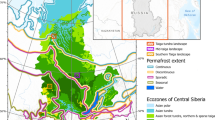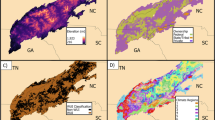Abstract
The human influence on environmental processes has been described for many types of land use. One of the oldest tools to modify people’s environment is fire, which has dominated fire regimes in many regions over long time scales. This paper focuses on a German case study region, where 80–90% of the fires are human-caused. The objectives of this study are the application of the Regional Fire Model (Reg-FIRM), a process-based fire model that is incorporated into the LPJ Dynamic Global Vegetation Model, to temperate forests under historic climate conditions and to explore ranges of potential impacts of future climate change on fire and vegetation dynamics. Simulation experiments are designed to simulate historic fire pattern and to explore influences of vegetation on fire. Simulated fire pattern reproduced the observed average fire conditions reasonably well although with a smaller amplitude. This leads to underestimation of extreme fire years as well as an overestimation of low fire years. Vegetation composition influenced fire spread conditions in the temperate forest and had little impact on fire ignition potentials, except when only broad-leaved deciduous forests were assumed. Fire is likely to change under climate change conditions. Simulated experiments were conducted to explore the effects of climate change and rising CO2 concentration given the potential natural vegetation as the best-case for Brandenburg. Three GCM scenarios predicting different future climatic changes were applied, and resulted in quantitatively different future fire patterns. Depending on future precipitation pattern and the influence of the CO2 effect on canopy conductance and thus litter moisture, fire was predicted to either decrease or slightly increase in Brandenburg forests, but the burnt area would not exceed current, extreme fire years. Generally, fire changes had no implication for vegetation composition in Brandenburg, but reduced vegetation carbon gain after 2050. In the HadCM3 application, simulated increase in grass cover due to a large burnt area after 2075 accelerated fire spread conditions, thus still increasing the burnt area, while climatic fire danger and number of fires already began to decline. These interactions underline the importance to consider the full range of fire processes and interactions with vegetation dynamics in a simulation model.
Similar content being viewed by others
Abbreviations
- CSIRO2:
-
The coupled model of the Commonwealth Scientific and Industrial Research Organisation (CSIRO, Australia), version 2.
- GCM:
-
General Circulation Model
- HadCM3:
-
Hadley Centre Coupled Model, version 3 (United Kingdom Met Office, UKMO, UK)
- LPJ-DGVM:
-
Lund-Potsdam-Jena Dynamic Global Vegetation Model
- PCM:
-
Parallel Climate Model (National Center for Atmospheric Research, NCAR, USA)
- Reg-FIRM:
-
Regional-scale fire model
References
Badeck, F.-W., Lasch, P., Hauf, Y., Rock, J., Suckow, F. and Thonicke, K.: 2004, Steigendes klimatisches Waldbrandrisiko. AFZ/Der Wald 59(2)
U. Cubasch G.A. Meehl G.J. Boer R.J. Stouffer M. Dix A. Noda C.A. Senior S. Raper K.S. Yap (2001) Projections of future climate change, Climate Change 2001 J.T. Houghton Y. Ding D.J. Griggs M. Noguer P.J. Linden Particlevan der X. Dai K. Maskell C.A. Johnson (Eds) The Scientific Basis Contribution of Working Group I to the Third Assessment Report of the Intergovernmental Panel of Climate Change Cambridge University Press Cambridge, United Kingdom, New York NY, USA 525–582
D.S. Ellsworth (1999) ArticleTitleCO2 enrichment in a maturing pine forest: are CO2 exchange and water status in the canopy affected? Plant Cell Environ. 22 461–472 Occurrence Handle10.1046/j.1365-3040.1999.00433.x
I.G. Enting T.M.L. Wigley M. Heimann (1994) Future Emissions and Concentrations of Carbon Dioxide: Key Ocean/Atmosphere/Land Analyses 31 CSIRO Division of Atmospheric Research Aspendale, Victoria, Australia
InstitutionalAuthorNameFAO (1991) The Digitized Soil Map of the World (Release 1.0). 67/1 Food and Agriculture Organization of the United Nations Rome, Italy
J.G. Goldammer S. Montag H. Page (1997) ArticleTitleNutzung des Feuers in mittel- uns Nordeuropäischen Landschaften. Geschichte, Methoden, Probleme, Perspektiven. NNA-Berichte 10 IssueID5 18–38
C. Gordon C. Cooper C.A. Senior H.T. Banks J.M. Gregory T.C. Johns J.F.B. Mitchell R.A. Wood (2000) ArticleTitleThe simulation of SST, sea ice extents and ocean heat transports in a version of the Hadley Center coupled model without flux adjustments Climate Dynamics 16 147–168 Occurrence Handle10.1007/s003820050010
H.B. Gordon S.P. O’Farrell (1997) ArticleTitleTransient climate change in the CSIRO coupled model with dynamic sea ice Monthly Weather Rev. 125 875–907 Occurrence Handle10.1175/1520-0493(1997)125<0875:TCCITC>2.0.CO;2
C. Hély Y. Bergeron M.D. Flannigan (2000) ArticleTitleEffects of stand composition on fire hazard in mixed-wood Canadian boreal forest J. Veget. Sci. 11 813–824
J.T. Houghton Y. Ding D.J. Griggs M. Noguer P.J. Linden Particlevan der X. Dai K. Maskell C.A. Johnson (2001) Climate Change 2001: The Scientific Basis Contribution of Working Group I to the Third Assessment Report of the Intergovernmental Panel of Climate Change Cambridge University Press Cambridge United Kingdom and New York NY USA 881
Krausch, H.-D. 1992 Potentielle natürliche Vegetation. Umweltbundesamt (Eds.), Ökologische Ressourcenplanung Berlin und Umland – Planungsgrundlagen. FB 90051 Berlin: Umweltbundesamt (pp. 8)
S. Lange (2000) ArticleTitleWaldbrandabwehr im 20.Jahrhundert. Beiträge deutscher Forstleute zur Vorbeugung und Bekämpfung Forst und Holz 55 IssueID8 253–259
P. Lasch F.-W. Badeck M. Lindner F. Suckow (2002a) ArticleTitleSensitivity of simulated forest growth to changes in climate and atmospheric CO2 Forstwiss. Centralblatt 121 IssueIDSupplement 1 155–171
P. Lasch M. Lindner B. Ebert M. Flechsig F.-W. Gerstengarbe F. Suckow P.C. Werner (1999) ArticleTitleRegional impact analysis of climate change on natural and managed forests in the Federal State of Brandenburg, Germany Environ. Modeling Assess. 4 IssueID4 273–286
P. Lasch M. Lindner M. Erhard F. Suckow A. Wenzel (2002b) ArticleTitleRegional impact assessment on forest structure and functions under climate change-the Brandenburg case study Forest Ecol. Manage. 162 IssueID1 73–86
InstitutionalAuthorNameLDS (2002) Bevölkerung des Landes Brandenburg 1955–2000 Landesbetrieb für Datenverarbeitung und Statistik Brandenburg (State Institution for data processing and statistics Brandenburg) Germany
InstitutionalAuthorNameLFE (2000) Waldbrandstatistik des Landes Brandenburg 1975–1999 Landesforstanstalt Eberswalde Germany
J.H. Li W.A. Dugas G.J. Hymus D.P. Johnson B.G. Drake B.A. Hungate (2003) ArticleTitleDirect and indirect effects of elevated CO2 on transpiration from Quercus myrtifolia in a scrub-oak ecosystem Global Change Biol. 9 IssueID1 96–105 Occurrence Handle10.1046/j.1365-2486.2003.00557.x
Mitchell, T.D., Carter, T.R., Jones, P.D., Hulme, M. and New, M.: 2004, A comprehensive set of climate scenarios for Europe. Tyndall Centre for Climate Change Research Working Paper 55, 25
InstitutionalAuthorNameMUNR (1998) Daten zur Umweltsituation im Land Brandenburg Ministerium für Umwelt, Naturschutz und Raumordnung des Landes Brandenburg (MUNR) Potsdam Germany
S. Pyne J.G. Goldammer (1997) The culture of fire: An introduction to anthropogenic fire history J.S. Clark H. Cachier J.G. Goldammer B. Stocks (Eds) Sediment Records of Biomass Burning and Global Change. Series 1: Global Environmental Change Springer Verlag Berlin 71–114
S.J. Pyne (1995) World Fire, Cycle of Fire Henry Holt and Company New York 379
S. Sitch et al. (2003) ArticleTitleEvaluation of ecosystem dynamics, plant geography and terrestrial carbon cycling in the LPJ Dynamic Global Vegetation Model Global Change Biol. 9 161–185 Occurrence Handle10.1046/j.1365-2486.2003.00569.x
W. Tobler U. Deichmann J. Gottsegen K. Maloy (1995) The Global Demography Project, National Center for Geographic Information and Analysis University of California Santa Barbara
S. Venevsky K. Thonicke S. Sitch W. Cramer (2002) ArticleTitleSimulating fire regimes in human-dominated ecosystems: Iberian Peninsula case study Global Change Biol. 8 984–998 Occurrence Handle10.1046/j.1365-2486.2002.00528.x
W.M. Washington J.W. Weatherly G.A. Meehl A.J. Semtner SuffixJr. T.W. Bettge A.P. Craig W.G. Strand SuffixJr. J. Arblaster V.B. Wayland R. James Y. Zhang (2000) ArticleTitleParallel Climate Model (PCM): Control and Transient simulations Climate Dynamics 16 755–774 Occurrence Handle10.1007/s003820000079
Author information
Authors and Affiliations
Corresponding author
Rights and permissions
About this article
Cite this article
Thonicke, K., Cramer, W. Long-term Trends in Vegetation Dynamics and Forest Fires in Brandenburg (Germany) Under a Changing Climate. Nat Hazards 38, 283–300 (2006). https://doi.org/10.1007/s11069-005-8639-8
Received:
Accepted:
Issue Date:
DOI: https://doi.org/10.1007/s11069-005-8639-8




